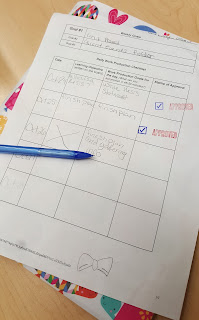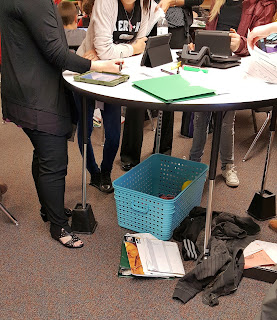This past week I was fortunate to visit three middle schools in the St. Vrain Valley School District. Almost the entire district has 1:1 devices (except for class sets in the elementary), encompassing 55 schools with about 32,000 students. All secondary students use iPad minis. I am lucky regardless as I have been a 1:1 iPad teacher for the last five years. The reason why I visited these schools is to see how the devices are utilized in an entire 1:1 school.
What I saw was eye-opening.
1. The district has their act together. Because they are such a large community, they had to plan for the implementation well before they purchased or even decided what devices to use. The teachers had time to use the devices before they used them in the classroom. The teachers get training from instructional technology coordinators and learning technology coaches. There is a common language among the district, so while visiting three different schools, the teachers and students said very similar things. Posters across the schools were also similar. Most importantly, they have a shared vision. As we visited classrooms, it seemed like every teacher was on board with the vision. It made me realize that District 49 needs to find a cohesive vision that does not change every year. And as we continue to use 1:1 devices, we need to be transparent and get the community on board. I do not feel like there is enough communication about why there are iPad teams at Skyview and how learning with the iPads is supposed to be purposeful and meaningful for the students' current and future education and future occupations.
2. The three schools were not any more advanced than my classroom. Most of the classrooms that we visited were simple substitution (on the SAMR model). I was disappointed that I did not see "more" - more student choice, more collaboration, more critical thinking. To be fair, we all have days where we have those typical, boring traditional lessons. But it was hard to see so many students listening to a teacher talk when they all have an iPad Mini in front of them. To be fair, I saw limited student disengagement which was exciting. And I think every student that we talked to was excited to have that device in front of them at all times.
3. There is inconsistency in every school. Some classrooms were better than others. At Trail Ridge Middle School, we saw two math classes that collaborate every day during Science class. It was fascinating as the two classes worked together to use both Math and Science concepts to create space shuttles for their space unit. Those students were so engaged that they did not even notice when we walked into the classroom. Then there were classes where the teacher lectured in the front of the room with the lesson on the front screen. The students were "grouped," but there was no discussion between them. There were some lost opportunities in a few rooms.
4. It's important for a student to explain what they know, but... there still has to be a point to what they are learning. I watched some students sit through classes that were not engaging, and when I asked them a question, they would dive into a spiel about their objective and what they were studying (but totally not answering my question). It felt like they had been coached and were not demonstrating learned knowledge and skills.
In the end, I was grateful to visit these classrooms and would love to do more observations in the future. I may also need to be a slight stalker and contact some of these teachers to potentially collaborate. There are exciting prospects on the horizon!
Some other things I pulled from observations:
 I loved this poster from a teacher's classroom. It's letting Ss and Ts know that phones are a part of students' world, and as a teacher, you respect that.
I loved this poster from a teacher's classroom. It's letting Ss and Ts know that phones are a part of students' world, and as a teacher, you respect that. I thought this was a great checklist handout. I know it's traditional and simple, but I think this would be beneficial for goal setting for the class AND staying on task throughout an extended project. I use checkpoints to keep Ss focused, but this would take it to another level.
I thought this was a great checklist handout. I know it's traditional and simple, but I think this would be beneficial for goal setting for the class AND staying on task throughout an extended project. I use checkpoints to keep Ss focused, but this would take it to another level. I loved at this 1:1 school that ALL posters in the hallway used QR codes. It's not anything groundbreaking, but it makes it clear to the Ss that the devices will be used. All QR codes let to Google Forms for the students to fill out. Many teachers also had #observeme posters, but they also included a QR code that let to a Google Form for an observer to lead feedback. Brilliant!
I loved at this 1:1 school that ALL posters in the hallway used QR codes. It's not anything groundbreaking, but it makes it clear to the Ss that the devices will be used. All QR codes let to Google Forms for the students to fill out. Many teachers also had #observeme posters, but they also included a QR code that let to a Google Form for an observer to lead feedback. Brilliant! In another classroom, the teacher had the students use post-it notes to put down goals for the day. It was simple but effective. The teacher kept asking the students about their goal and what they still had to do. The Ss had to reflect throughout class which was impressive.
In another classroom, the teacher had the students use post-it notes to put down goals for the day. It was simple but effective. The teacher kept asking the students about their goal and what they still had to do. The Ss had to reflect throughout class which was impressive. I loved that a teacher used risers to make one table a standing table. I've been reading about teachers getting rid of their teacher desk, and after seeing this, I think I am going to get rid of mine. My desk is literally full of crap that I rarely use, so why do I have it?! I have been looking at a table from Ikea that I could raise with bed risers. My plan is to use the table as both my teacher desk AND as a great place to converse with Ss.
I loved that a teacher used risers to make one table a standing table. I've been reading about teachers getting rid of their teacher desk, and after seeing this, I think I am going to get rid of mine. My desk is literally full of crap that I rarely use, so why do I have it?! I have been looking at a table from Ikea that I could raise with bed risers. My plan is to use the table as both my teacher desk AND as a great place to converse with Ss. Thanks for reading! I'll see you next week :)
- Rachel
@historicalipad
My Teacherspayteachers website